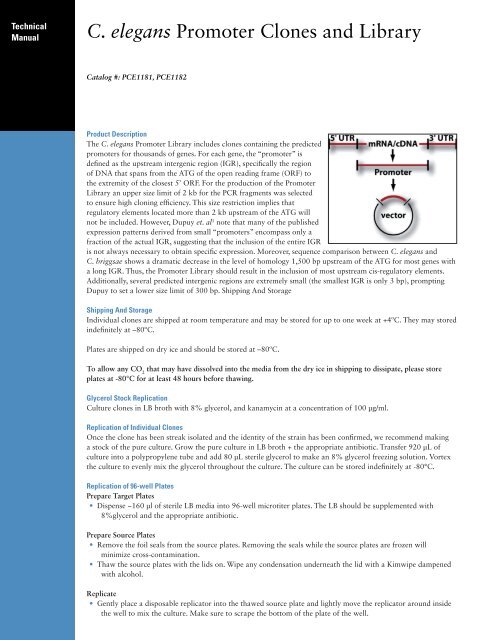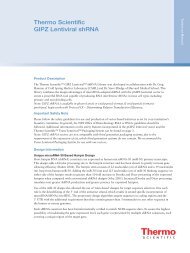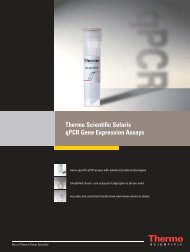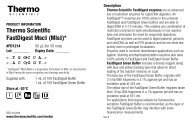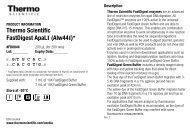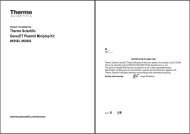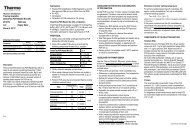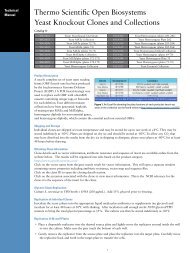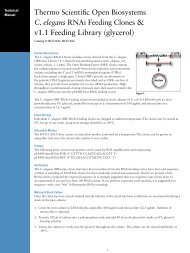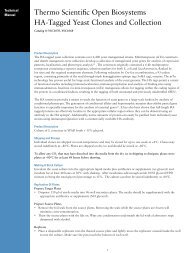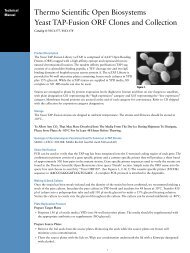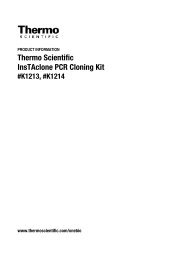C. elegans Promoter Clones and Library - Thermo Scientific
C. elegans Promoter Clones and Library - Thermo Scientific
C. elegans Promoter Clones and Library - Thermo Scientific
Create successful ePaper yourself
Turn your PDF publications into a flip-book with our unique Google optimized e-Paper software.
Technical<br />
Manual<br />
C. <strong>elegans</strong> <strong>Promoter</strong> <strong>Clones</strong> <strong>and</strong> <strong>Library</strong><br />
Catalog #: PCE1181, PCE1182<br />
Product Description<br />
The C. <strong>elegans</strong> <strong>Promoter</strong> <strong>Library</strong> includes clones containing the predicted<br />
promoters for thous<strong>and</strong>s of genes. For each gene, the “promoter” is<br />
defined as the upstream intergenic region (IGR), specifically the region<br />
of DNA that spans from the ATG of the open reading frame (ORF) to<br />
the extremity of the closest 5’ ORF. For the production of the <strong>Promoter</strong><br />
<strong>Library</strong> an upper size limit of 2 kb for the PCR fragments was selected<br />
to ensure high cloning efficiency. This size restriction implies that<br />
regulatory elements located more than 2 kb upstream of the ATG will<br />
not be included. However, Dupuy et. al 1 note that many of the published<br />
expression patterns derived from small “promoters” encompass only a<br />
fraction of the actual IGR, suggesting that the inclusion of the entire IGR<br />
is not always necessary to obtain specific expression. Moreover, sequence comparison between C. <strong>elegans</strong> <strong>and</strong><br />
C. briggsae shows a dramatic decrease in the level of homology 1,500 bp upstream of the ATG for most genes with<br />
a long IGR. Thus, the <strong>Promoter</strong> <strong>Library</strong> should result in the inclusion of most upstream cis-regulatory elements.<br />
Additionally, several predicted intergenic regions are extremely small (the smallest IGR is only 3 bp), prompting<br />
Dupuy to set a lower size limit of 300 bp. Shipping And Storage<br />
Shipping And Storage<br />
Individual clones are shipped at room temperature <strong>and</strong> may be stored for up to one week at +4ºC. They may stored<br />
indefinitely at –80ºC.<br />
Plates are shipped on dry ice <strong>and</strong> should be stored at –80ºC.<br />
To allow any CO 2 that may have dissolved into the media from the dry ice in shipping to dissipate, please store<br />
plates at -80°C for at least 48 hours before thawing.<br />
Glycerol Stock Replication<br />
Culture clones in LB broth with 8% glycerol, <strong>and</strong> kanamycin at a concentration of 100 μg/ml.<br />
Replication of Individual <strong>Clones</strong><br />
Once the clone has been streak isolated <strong>and</strong> the identity of the strain has been confirmed, we recommend making<br />
a stock of the pure culture. Grow the pure culture in LB broth + the appropriate antibiotic. Transfer 920 μL of<br />
culture into a polypropylene tube <strong>and</strong> add 80 μL sterile glycerol to make an 8% glycerol freezing solution. Vortex<br />
the culture to evenly mix the glycerol throughout the culture. The culture can be stored indefinitely at -80°C.<br />
Replication of 96-well Plates<br />
Prepare Target Plates<br />
• Dispense ~160 μl of sterile LB media into 96-well microtiter plates. The LB should be supplemented with<br />
8%glycerol <strong>and</strong> the appropriate antibiotic.<br />
Prepare Source Plates<br />
• Remove the foil seals from the source plates. Removing the seals while the source plates are frozen will<br />
minimize cross-contamination.<br />
• Thaw the source plates with the lids on. Wipe any condensation underneath the lid with a Kimwipe dampened<br />
with alcohol.<br />
Replicate<br />
• Gently place a disposable replicator into the thawed source plate <strong>and</strong> lightly move the replicator around inside<br />
the well to mix the culture. Make sure to scrape the bottom of the plate of the well.
• Gently remove the replicator from the source plate <strong>and</strong> gently place the replicator into the target plate. Gently<br />
move the replicator back <strong>and</strong> forth in the target plate to transfer cells.<br />
• Discard the replicator.<br />
• Place the lids back on the source plates <strong>and</strong> target plates.<br />
• Seal the source plates, being mindful to avoid cross contamination.<br />
• Repeat this process until all plates have been replicated.<br />
• Return the source plates to the –80ºC freezer.<br />
• Place the inoculated target plates in a 37ºC incubator. Incubate the plates for 12–24 hours.<br />
Vector Information<br />
References<br />
Denis Dupuy, Qianru Li, Bart Deplancke, Mike<br />
Boxem, Tong Hao, Philippe Lamesch, Reynaldo<br />
Sequerra, Stephanie Bozak, Lynn Doucette-<br />
Stamm, Ian A. Hope, David E. Hill, Albertha J.M.<br />
Walhout, <strong>and</strong> Marc Vidal. Caenorhabditis <strong>elegans</strong><br />
<strong>Promoter</strong>ome 1.1: a Gateway to Localizome<br />
Projects.<br />
Figure 1. pDONR TM P4-P1R vector map<br />
rrnB T2 transcription termination sequence: bases<br />
268-295 (c)<br />
rrnB T1 transcription termination sequence: bases<br />
427-470 (c)<br />
M13 Forward (-20) priming site: bases 537-552<br />
attP4 recombination site: bases 593-824 (c)<br />
ccdB gene: bases 1181-1486 (c)<br />
Chloramphenicol resistance gene: bases 1828-2487 (c)<br />
attP1R recombination site: bases 2748-2979 (c)<br />
M13 Reverse priming site: bases 3042-3058<br />
Kanamycin resistance gene: bases 3171-3980<br />
pUC origin: bases 4101-4774<br />
(c) = complementary str<strong>and</strong><br />
Useful Websites<br />
WorfDB, the C. <strong>elegans</strong> ORFeome Cloning Project Database<br />
http://worfdb.dfci.harvard.edu/<br />
WormBase web site<br />
http://www.wormbase.org<br />
FAQS/Troubleshooting<br />
For answers to questions that are not addressed here, please email technical support at<br />
openbiosystems@thermofisher.com with your question, your sales order or purchase order number <strong>and</strong> the catalog<br />
number or clone ID of the construct or collection with which you are having trouble.<br />
Alternatively, you can search our online FAQ database: https://www.openbiosystems.com/Help/FAQ/<br />
Contact Information<br />
Technical Support<br />
Tel: 1.888.412.2225<br />
Fax: 1.256.704.4849<br />
openbiosystems@<br />
thermofisher.com<br />
© 2009 <strong>Thermo</strong> Fisher<br />
<strong>Scientific</strong> Inc. All rights<br />
reserved. Trademarks<br />
are the property of their<br />
respective owners. All<br />
other trademarks are<br />
the property of <strong>Thermo</strong><br />
Fisher <strong>Scientific</strong> Inc.<br />
<strong>and</strong> its subsidiaries. For<br />
Research Use Only.


